Text Size
IBEX Media Teleconference: Visuals
10.06.08
> Press Release
> Feature story
> IBEX litho
> IBEX Fact Sheet
> IBEX Q&A
> Other IBEX Multimedia
> Presenters biographies and photos
Presenters Multimedia:
Presenter 1: Willis Jenkins, Program Executive (Biography)
1) Explorers program chart
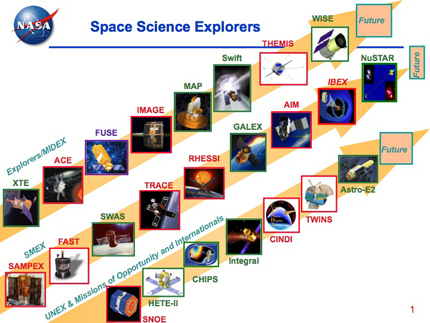
> Full resolution chart
Presenter 2: Greg Frazier, Mission Manager (Biography)
2) IBEX spacecraft photo

> Full resolution photo
Image credit: Southwest Research Institute
3) IBEX flight system
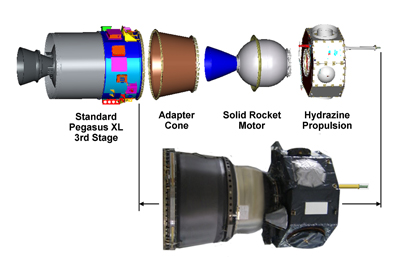
> Full resolution image
Image credit: Southwest Research Institute
4) IBEX launch sequence

> Play animation
Animation credit: Walt Feimer/NASA GSFC
The IBEX team designed a groundbreaking concept for placing a spacecraft into high-altitude orbit using the least expensive launch vehicle in NASA's arsenal -- a Pegasus rocket -- coupled with an additional IBEX-supplied solid rocket motor and the spacecraft's hydrazine propulsion system. Pegasus will deliver IBEX to an altitude of about 120 miles, point it in the desired direction, spin it up to 60 rpm and release it. After discarding a lightweight adapter cone, the additional IBEX STAR-27 SRM will carry IBEX into a medium-altitude parking orbit. After discarding the spent SRM casing, IBEX will use its internal hydrazine system over several orbits to raise its apogee to 200,000 miles and its perigee to about 4,400 miles above the Earth.
Presenter 3: Dave McComas, Principal Investigator (Biography)
5) Simulated view of our heliosphere in the galaxy
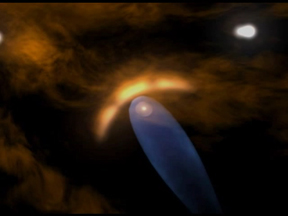
> View animation
Animation credit: Walt Feimer/NASA GSFC
6) Other astrospheres exist throughout the galaxy
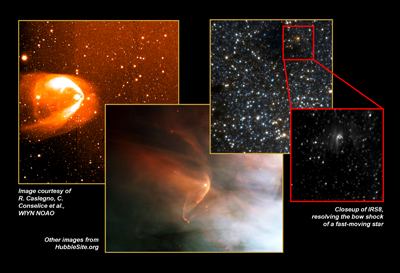
> Full resolution image
Image credit: R. Caslegno, C. Conselice et al., WIYN NOAO
7) The heliosphere
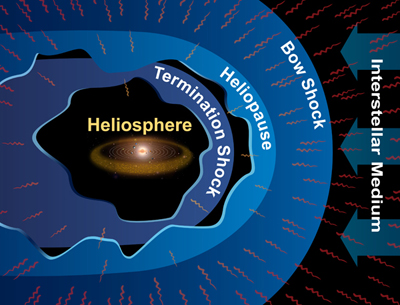
> Full resolution image
Image credit: Southwest Research Institute
The heliosphere, in which the Sun and planets reside, is a large bubble inflated from the inside by the high-speed solar wind blowing out from the Sun. Pressure from the solar wind, along with pressure from the surrounding interstellar medium, determines the size and shape of the heliosphere. The heliosphere also is responsible for shielding out one-tenth of the galactic radiation coming in from the interstellar medium. IBEX will be the first spacecraft to observe the invisible interactions occurring at this boundary. The supersonic flow of solar wind abruptly slows at the termination shock, the innermost boundary of the solar system. The edge of the solar system is the heliopause. The bow shock pushes ahead through the interstellar medium as the heliosphere plows through the galaxy.
8) Voyager 1 and Voyager 2

> Full resolution image
Image credit: Walt Feimer/NASA GSFC
Voyagers 1 and 2 reached the termination shock in 2005 and 2007, respectively, taking point measurements as they left the solar system. While exciting and valuable, the data they provided about this region raised more questions than they resolved. IBEX will use energetic neutral atom imaging to, for the first time, make global images of the complex interactions (simulated in animation) occurring at the edge of the solar system. The spacecraft will complete one all-sky map every six months.
9) Charge exchange
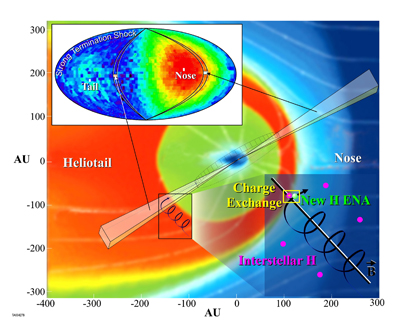
> Full resolution image
Image credit: Southwest Research Institute
From its vantage far above Earth's relatively bright magnetosphere, the spacecraft's energetic neutral atom (ENA) sensors will assemble global images that reveal the broad heliospheric interactions for the first time. These ENAs are produced by a process called "charge exchange," which neutralizes previously charged particles in the interactive region within the interstellar medium. Once neutralized, some ENAs travel inward toward the Sun where they can be observed by the spacecraft.
10) Parting thoughts
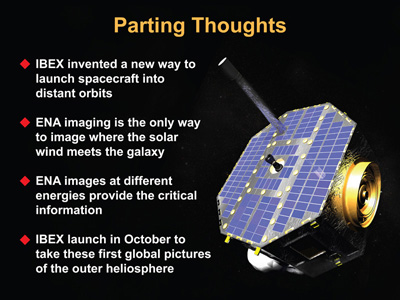
> Full resolution image
Background image credit: Walt Feimer/NASA GSFC
Related Resources
1) Animation: Voyager data vs. IBEX data Animation credit: Southwest Research Institute
Voyagers 1 and 2 reached the termination shock in 2005 and 2007, respectively, taking point measurements as they left the solar system. While exciting and valuable, the data they provided about this region raised more questions than they resolved. IBEX will use energetic neutral atom imaging to, for the first time, make global images of the complex interactions (simulated in animation) occurring at the edge of the solar system. The spacecraft will complete one all-sky map every six months.
2) Animation: All-sky image via rotation Animation credit: Southwest Research Institute
The IBEX spacecraft rotates at 4 revolutions per minute. The sensors, which look out perpendicular to its sun-pointed axis, use a charge exchange process to convert energetic neutral atoms (ENAs) into ions so they can be analyzed and detected. As the spacecraft rotates, the sensors build a crescent-shaped portion of the all-sky map.
3) Animation: All-sky image via orbit Animation credit: Southwest Research Institute
As IBEX orbits, it builds on the crescent shape captured by its rotation until it completes the all-sky map in about six-months. These maps will reveal the structures, dynamics, energetic particle acceleration, and charged particle propagation in this very complex but important region.
Presenter 4: Eric Christian, Program Scientist (Biography)
No visuals.
Additional Resources
1) IBEX science team Image credit: Southwest Research Institute
2) Spacecraft assembly Image credit: Southwest Research Institute
3) Education and public outreach led by Adler Planetarium Image credit: Adler Planetarium
4) Introduction to IBEX video. Video credit: Southwest Research Institute
5) What is an IBEX? Image credit: Southwest Research Institute